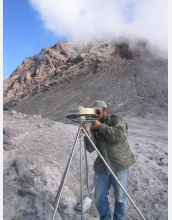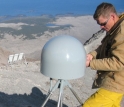News Release 06-028
Instruments on Alaska's Augustine Volcano Provide New Insights into Volcanic Processes

T. Corbett (EarthScope) finishes installation of GPS station.
February 9, 2006
B-roll of the sensors on the volcano is available. Contact Dena Headlee at dheadlee@nsf.gov
This material is available primarily for archival purposes. Telephone numbers or other contact information may be out of date; please see current contact information at media contacts.
As Alaska's Augustine Volcano erupts and sends a plume of ash more than 40,000 feet into the air, instruments on the ground are recording rumblings at the volcano's surface. The data collected will provide new insights into the inner workings of volcanoes along the Pacific rim.
Scientists affiliated with EarthScope--a vast North American geologic observatory funded by the National Science Foundation (NSF)--have placed permanent, continuously recording GPS stations on volcanoes, including Augustine, across the continent.
A large stratovolcano located in the southern Cook Inlet southwest of Anchorage, Augustine is one of the region's most active volcanoes. But it has been quiet since its last eruption in 1986. The reemergence of activity on Augustine began last May with an increase in the number of earthquakes. Soon a slow, steady increase in the volcano's movements occurred, recorded in detail by EarthScope Plate Boundary Observatory (PBO) GPS stations installed on the volcano's flanks.
Augustine began erupting in mid-Jan. with a series of explosions. Ash spewed so high into the atmosphere that jets were forced to alter their routes as they traveled to and from Asia. The Alaska Volcano Observatory uses EarthScope data to alert the FAA and first responders to dangerous volcanic activity.
"Capturing episodes of volcanic unrest like the one at Augustine will lead to a better understanding of volcanic processes, as well as improved natural-hazard response and mitigation efforts," said Kaye Shedlock, program director for EarthScope at NSF.
"Earthquake swarms are common under volcanoes," said geologist Jeffrey Freymueller of the University of Alaska at Fairbanks, "and result in movement of the volcano's surface." In fact, the EarthScope GPS station located closest to Augustine's summit has been creeping away from its original location in response to the volcano's eruptions, said Freymueller. "Capturing daily, even hourly, movement of volcanoes in real time brings a new dimension to volcano research and hazard response," he said.
Researchers usually make measurements once a year to record movement of a volcano, said Michael Jackson, PBO director. "The odds of capturing a signal from Augustine within the short timeframe it occurred would have been next to nil without permanent EarthScope stations on the surface," said Jackson.
UNAVCO, a university consortium, is constructing the EarthScope Plate Boundary Observatory for NSF.
The activity on Augustine is far from over, said Greg Van der Vink, EarthScope project director, and in fact, may only be beginning. In the past, Augustine has erupted in two phases, an explosive phase, much like the volcano's current fury, and a dome-building phase.
Meanwhile, scientists are pouring over data to understand the volcano's current status, and to look for clues to its future. As the eruption continues, GPS instruments will continue to track the volcano's "breathing" as it shrinks and swells due to the movement of magma.
Ash and the force of eruptions have damaged some GPS stations near Augustine's summit. Data from the volcano continue to be valuable, even when stations are lost, said scientist Peter Cervelli of the Alaska Volcano Observatory. "You have to think of these instruments as space probes, hoping they transmit data until the last moment."
-NSF-
-
Station AV05, closest to Augstine's summit, has been missing since the Jan. 13, 2006 eruptions.
Credit and Larger Version -
Station AV01, east of Augustine's summit, survived the recent eruptions and sends hourly data.
Credit and Larger Version
Media Contacts
Cheryl Dybas, NSF, (703) 292-7734, email: cdybas@nsf.gov
Charna Meth, EarthScope, (202) 682-0633, email: cmeth@earthscope.org
Related Websites
EarthScope Project: http://www.earthscope.org
Alaska Volcano Observatory: http://www.avo.alaska.edu
The U.S. National Science Foundation propels the nation forward by advancing fundamental research in all fields of science and engineering. NSF supports research and people by providing facilities, instruments and funding to support their ingenuity and sustain the U.S. as a global leader in research and innovation. With a fiscal year 2023 budget of $9.5 billion, NSF funds reach all 50 states through grants to nearly 2,000 colleges, universities and institutions. Each year, NSF receives more than 40,000 competitive proposals and makes about 11,000 new awards. Those awards include support for cooperative research with industry, Arctic and Antarctic research and operations, and U.S. participation in international scientific efforts.
Connect with us online
NSF website: nsf.gov
NSF News: nsf.gov/news
For News Media: nsf.gov/news/newsroom
Statistics: nsf.gov/statistics/
Awards database: nsf.gov/awardsearch/
Follow us on social
Twitter: twitter.com/NSF
Facebook: facebook.com/US.NSF
Instagram: instagram.com/nsfgov




